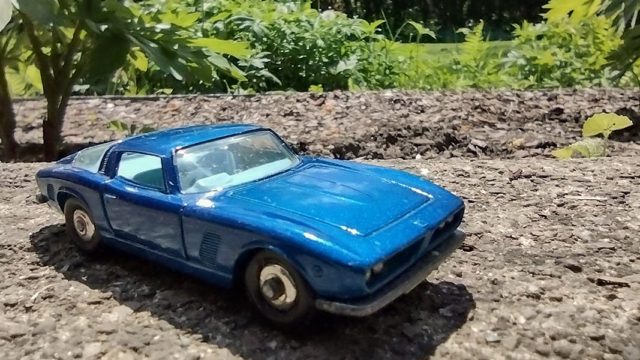In 1965, when I was six, my parents started giving me Matchbox cars. I would get two or three on each birthday and another two or three at Christmas. I began to save my fifteen-cent-a-week allowance for them. One car cost fifty cents at the Woolworth’s, a ten-minute walk from my house. For my eighth birthday I got an Official Matchbox Collector’s Case that could hold 48 cars. Two years later I got an Official Deluxe Collector’s Case that could hold 72 cars.
I did the usual things: I drove them down the lanes of the pine floor boards in my bedroom; I lifted and dropped a blanket on my bed to create humps and folds that became hills and hill roads; I combined them with an HO train set and HO scale model houses I’d built from kits, turning left and right on notional streets, crossing the tracks safely after the train went by. I never caused them to crash down the stairs, and I always put them away in the two cases when I was done.
Twenty-five years later, visiting my parents, I found them in the back of a closet. When I looked at them, it wasn’t the makes and models of the cars that hit me between the eyes, it was the colors. It seemed as though I had never seen those exact shades since my childhood. In particular, there was a dark blue 1966 Iso Grifo that pulled me into a wordless and depthless nostalgic pool. Was that a dark royal blue? A cobalt blue? It felt that I needed to name it to get control of the emotion suffusing me, but no label seemed adequate. It was an enthralling, unnameable blue.
I brought the Matchbox cars to my own home in Ithaca, New York, and started giving them to my two daughters, aged five and two. I’d give each daughter two or three cars for her birthday and at Christmas. I played with them, too, driving the cars down the floorboards, turning corners, saying “vroom.” Meanwhile, my daughters would build garages out of colored blocks and park the cars cozily in them and leave them there to nap. Boys would come to play and they would crash the cars into each other, throw them down the stairs, step on them, walk off with a favorite hidden in their jeans pocket. I didn’t mind much. At least they were getting played with again.
But I held back a few, like the Iso Grifo. The ones I see for sale online look like they’ve been crashed down an awful lot of stairs, whereas mine is in mint condition. A pricing guide tells me it’s worth eighty-seven dollars.
It’s been another twenty-five years since I found it in my parents’ closet, and I still take it out now and then and gaze at it. The liquid color of its front hood (is it cerulean? is it azure? is that embossed shape a stylized diving board?) still entrances me.

I have that car, but I think it’s a larger model than the Matchbox. And yes, I love that color!
Geez! I just had to check my attic. The Iso Grifo is one of the few I kept. It’s a Corgi Whizzwheels version.
Your book is like a time machine to my childhood obsessions, nuclear obliteration being high on the list of them, of course.
https://www.etsy.com/listing/931969995/vintage-corgi-toys-whizzwheels-iso-griff
Hi Gary,
Along with Matchbox cars I had a number of Husky’s, which were rebranded as Corgi Juniors (including Whizzwheels) I think in 1970; it was the same year Matchbox introduced their Superfast line. All of this was to compete with Hot Wheels. I know that I and my parents must have stopped buying Matchbox and Husky cars by 1970, because I never owned any of the Superfast line or the Whizzwheels. I did go in for Hot Wheels in a big way, and spent a lot of time when I was eleven and twelve putting together those long orange tracks with the loop-to-loops and red jump trestles. I always felt that the banked curves weren’t designed properly; the Hot Wheels cars would enter the curve fine, then careen off the connected track when they exited it. An interesting social-historical note (unless it’s an urban myth): years later when I tried to buy additional Hot Wheels tracks for my daughters I found they were only selling shorter segments, which seemed like a bad design. A retailer told me that Mattel shortened the track segments because kids were using the long track segments to whip each other.
I had the same car around 1970, I was 5. I also loved the blue, but my favorite blue was a similar one Lego used on a battery operated locomotive. I loved the Grifo mostly because of its fluid lines (I never had heard about italian design, but it seemed to be all that a sports car should be…). Unfortunately I stepped on it once, so the front pilars were smashed and during a house move it disappeared.
Like novels read when I was twelve, colors of my early childhood provoked (or conveyed?) an emotional intensity that has never been equalled since. I suspect it’s true for many people; it seems to be true for you. I also had a red Matchbox Rolls Royce Silver Shadow, and no shade of red since then has ever come close to its enthralling beauty.